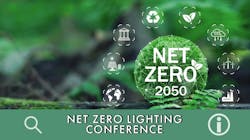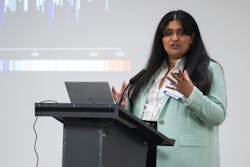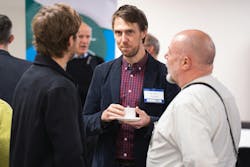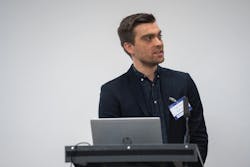Lighting industry’s net-zero efforts span energy sources, materials, and collaboration
Lighting companies looking to drastically reduce their carbon footprint could take high-profile measures such as installing solar panels on factory rooftops. Less visibly, they could squeeze more goods onto pallets.
Those are just two approaches ranging from the flashy to the mundane that speakers described at the recent Net Zero Lighting Conference in London, where they emphasized the broad set of actions that will be necessary to collectively achieve substantial environmental progress.
In no small measure, that breadth includes working with suppliers and customers, sometimes making the difficult decision of parting ways if a partner does not play eco ball.
“Decarbonizing our industry is a hugely ambitious project,” said Lighting Industry Association (LIA) CEO Ayça Donaghy in a rallying cry that opened the May 2nd confab, co-sponsored by the LIA (the U.K.’s industry body) and by Croydon, England–based lighting reuse specialist Recolight.
“We must continue to evolve our practices ensuring they contribute positively to the environment and society,” she continued, entreating vendors and end users alike to “rethink how we manage the life cycle of our products” and to “explore broader, more holistic approaches that include reuse, reduction, and redesign of lighting products.”
“Decarbonization is a very big fish to fry,” agreed Taran Rai, corporate sustainability manager of Epson UK, one of the few end users presenting at the conference. “I’m not sure we have a frying pan big enough. But trying is the main thing. Try to implement the changes where you can.”
A number of U.K. lighting vendors took to the podium to describe their eco initiatives, typically framing them in terms of “Scope 1, Scope 2, and Scope 3,” which are three categories defined by Greenhouse Gas Protocol, the international accounting and guidance outfit.
GHG Protocol is a joint effort of the Washington, D.C.–based World Resources Institute and the Geneva, Switzerland–based World Business Council for Sustainable Development. In its widely used assessment methods for greenhouse gas reduction, Scope 1 pertains to direct energy use, such as fuel for fleet vehicles; Scope 2 to energy purchased, such as electricity or gas for office and factory operations; and Scope 3 to greenhouse emissions across a company’s value chain.
All three categories come with challenges, and reaching “net zero” — the state of no emissions — in any of them is not easy. That is why many companies both inside and outside the lighting industry are currently settling for the more lenient “carbon neutral” over net zero, often engaging in carbon offset practices such as planting trees or purchasing carbon credits, as LEDs Magazine reported in our first story from the conference.
Beware the company you keep
Perhaps the most difficult of the categories in which to reach net zero is Scope 3 — the value chain — as it can entail applying pressure on suppliers and customers to switch to what might be inconvenient or costly green practices. Such pressure could be awkward, and could potentially lead to a loss of business with the other party.
Speakers at the conference described how they are nevertheless braving the process.
“We’ve changed the way we procure,” said Nigel Harvey, CEO of Recolight, which in addition to facilitating luminaire reuse also provides middleman services in luminaire and lamp recycling. “We’ve asked recyclers to demonstrate what they’re doing to decarbonize their business operations. So we’ve made net zero action one of the key criteria in supplier selection.”
Recolight queries its partners about their various internal operations including heating, cooling, energy reduction, insulation, and travel policies.
“Changing your procurement to encourage your suppliers to do the right thing does have an impact,” Harvey said.
At least one of Recolight’s recycling suppliers, Balcan Engineering, recently installed 188 solar panels on a rooftop.
“I have no doubt they wouldn’t have made that change if we hadn’t been pushing them to do the right thing,” Harvey noted.
Likewise, London-based designer and specifier Nulty is declining to use lighting manufacturers if they fail to provide data about their circular practices under the TM66 scheme devised by the LIA, said Nulty director Gary Thornton. Nulty implemented the policy in April 2023.
“We didn’t know how it was going to go,” Thornton recalled. “We had some very awkward conversations with manufacturers, particularly the ones that weren’t so familiar with TM66. A couple of manufacturers couldn’t, or wouldn’t, give us that data. We had to have the conversation that ‘our position is such that we’re now going to have to swap you out on the spec. Our position is this is what we’re designing to now. If you can’t give us that data, you score a zero.’”
Six months later the manufacturer began providing the data, Thornton said.
“All this talk we’ve been having about ‘yes, let’s be more circular, let’s design schemes made up of more circular principles’ — it’s really easy to talk and less easy to do,” Thornton noted. “And part of the ‘doing’ is us as specifiers putting pressure on manufacturers.”
Data dilemma
There are numerous reasons why a supplier might not provide data.
In its dealings with suppliers, U.K. LED lighting vendor Whitecroft, which is part of the Swedish Fagerhult Group, has found that often the information simply doesn’t exist.
“Because net zero is such a new concept to a lot of organizations, there is a real restriction around the amount of knowledge and understanding that organizations have,” said Whitecroft health, safety, and sustainability officer Oliver Wallace. “Certainly the smaller organizations that we work with, that supply to us, they just haven’t got the resources and the competencies to facilitate that.”
Suppliers can be restricted by costs of both software and staff to compile data, he noted, adding that the quality of the data can sometimes be questionable when it does come in.
Working with partners and providers to achieve eco objectives can take many forms.
Recolight’s Harvey encouraged companies to choose banks with environmentally responsible practices, for instance.
Epson’s Rai described several initiatives. One on the seemingly mundane side relates to pallets.
“Pallet optimization is something that we focused on last year,” said Rai, who spoke not just as a lighting end user but also as a manufacturer — albeit a printer maker, not a lighting outfit. “Now we can fit more boxes onto a pallet than we could before. We’ve had that conversation with our suppliers. Which means you’re fitting more boxes into a container, which means less deliveries going out, less containers going out, therefore reduced emissions.”
Epson also tracks the emissions of the container ships it hires, with the aim of using shipping companies that emit less than others.
On a related note, CEO Catherine Connolly of Knightsbridge — the Dunstable, England–based arm of Germany’s SLV Lighting Group — described how the company has overhauled its packaging to use less material and to increase its use of recyclable material.
LEDs will report further on some of these moves and on other presentations from the Net Zero Lighting Conference, looking at themes spanning reuse, recycling, logistics, and the myriad of environmental metrics and standards.
MARK HALPER is a contributing editor for LEDs Magazine, and an energy, technology, and business journalist ([email protected]).
Follow our LinkedIn page for our latest news updates, contributed articles, and commentary, and our Facebook page for events announcements and more. You can also find us on the X platform.

Mark Halper | Contributing Editor, LEDs Magazine, and Business/Energy/Technology Journalist
Mark Halper is a freelance business, technology, and science journalist who covers everything from media moguls to subatomic particles. Halper has written from locations around the world for TIME Magazine, Fortune, Forbes, the New York Times, the Financial Times, the Guardian, CBS, Wired, and many others. A US citizen living in Britain, he cut his journalism teeth cutting and pasting copy for an English-language daily newspaper in Mexico City. Halper has a BA in history from Cornell University.








![The DesignLights Consortium continues to make progress in shifting outdoor lighting products and implementation practices toward a more restrained and thoughtful strategy. [Image does not represent a DLC qualified fixture.] The DesignLights Consortium continues to make progress in shifting outdoor lighting products and implementation practices toward a more restrained and thoughtful strategy. [Image does not represent a DLC qualified fixture.]](https://img.ledsmagazine.com/files/base/ebm/leds/image/2024/08/66be810888ae93f656446f61-dreamstime_m_265700653.png?auto=format,compress&fit=&q=45&h=139&height=139&w=250&width=250)

